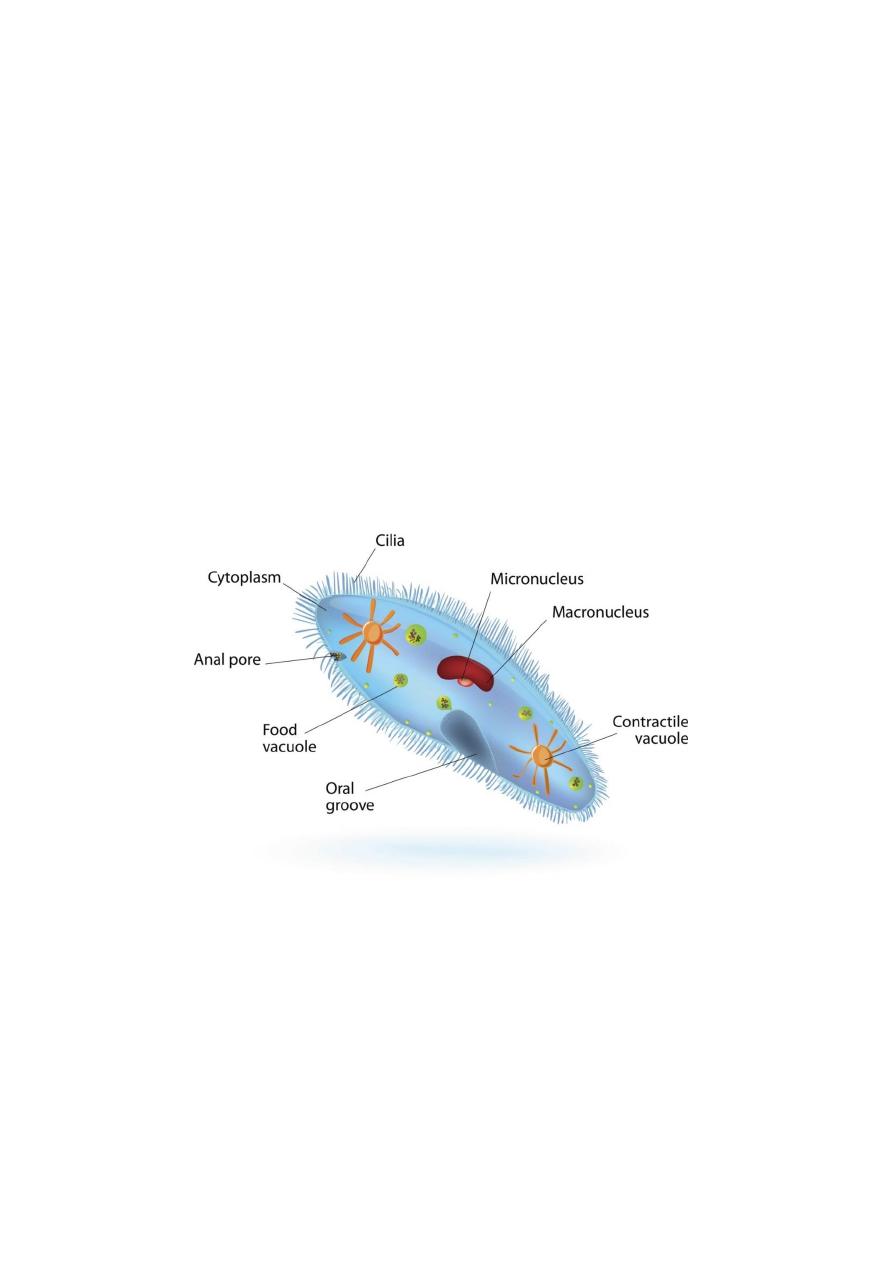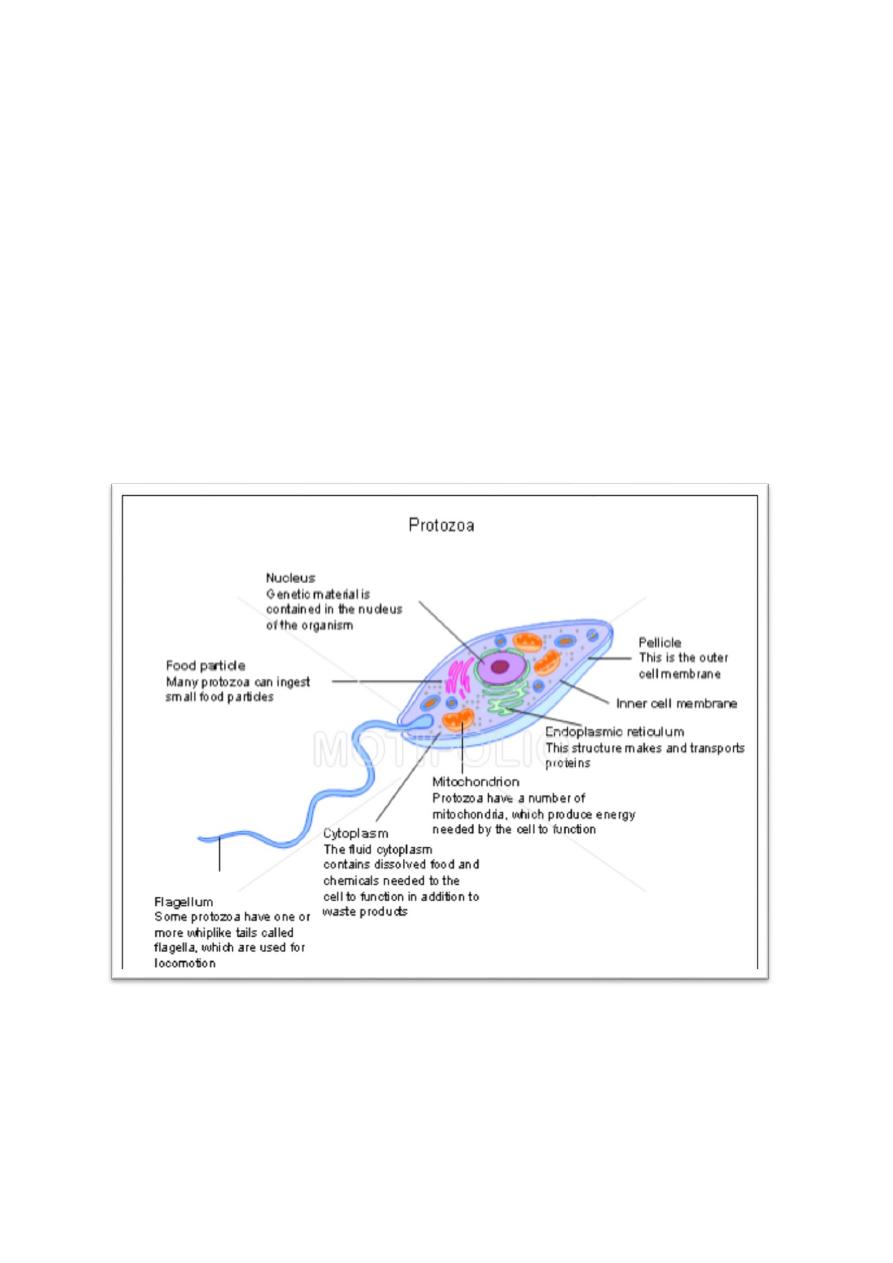
1
Course: Microbial Physiology
Lecturer: Dr. Weam Saad
Lecture: Protozoa
Protozoa Physiology
Protozoa: they are living microorganisms, eukaryotes, unicellular,
found
worldwide in
the environment and similar to animals in two characters: mobility
and heterotrophy. They are grouped in the kingdom Protista together with the
plant-like algae and fungus-like water molds and slime molds. Some protozoa
have one true nucleus like Amoeba, and others have two nucleuses like
Paramecium and Giardia.
Classification of protozoa:
1. According to type of nutrition: autotrophy, e.g. Euglena sp. Which have
chloroplast and generate energy by photosynthesis like plants.
Heterotrophy, like Amoeba and Paramecium.
2. Mode of living or habitat, like free living protozoa, e.g. free Amoeba, and
parasitic protozoa, e.g. Entamoeba histolytica 9the pathogen of human
colitis dysentery.
3. Type of moving and Transmission, by pseudopodia formation, e.g. free
Amoeba. By flagellum, e.g. Giardia, by cilia like Paramecium. By vector
like insects for parasitic protozoa, e.g. Leishmania by sand fly mosquito
bite.
4. Type of nutrition, pinocytosis, e.g. Paramecium and phagocytosis, e.g.
Amoeba.
Reproduction of Protozoa:
The stages of parasitic protozoa that actively feed and multiply are frequently
called trophozoites. Cysts are stages with a protective stage with thick wall.
Protozoan cysts that survive outside the host usually have more resistant walls
than trophozoits and enable the parasite to survive in the outside environment
for a period ranging from days to a year, depending on the species and
environmental conditions.

2
Binary fission, the most common form of reproduction, is asexual; multiple
asexual division occurs in some forms. Both sexual and asexual reproduction
occur in some protozoa like Plasmodium sp. (pathogen of malaria).
During its life cycle, a protozoan generally passes through several stages that
differ in structure and activity. In parasitic species this is the stage usually
associated with pathogenesis. In the hemoflagellates the terms amastigote,
promastigote, epimastigote, and trypomastigote designate trophozoite stages
that differ in the absence or presence of a flagellum.
Oocysts are stages resulting from sexual reproduction in the Apicomplexa.
Some apicomplexan oocysts are passed in the feces of the host, like cats for the
protozoa Toxoplasma gondii.
Structure of Protozoa:
Protozoa are unicellular eukaryotes, the nucleus is enclosed in a membrane.
The ciliates have both a micronucleus and macronucleus. The organelles of
protozoa have functions similar to the organs of higher animals. The plasma
membrane enclosing the cytoplasm also covers the projecting structures such as
pseudopodia, cilia, and flagella.

3
The outer surface layer of some protozoa, termed a pellicle, is rigid to maintain
the shape, as in Giardia. In most protozoa the cytoplasm is differentiated into
ectoplasm (the outer, transparent layer) and endoplasm (the inner layer
containing organelles); the structure of the cytoplasm is obvious in the species
with pseudopodia, such as the Ameba. Some protozoa have a cytosome or cell
“mouth” for ingesting fluids or solid particles. Contractile vacuoles for
osmoregulation found in some protozoa, such as Naegleria and Balantidium.
Many other structures found in parasitic protozoa, including the Golgi
apparatus, mitochondria, lysosomes, food vacuoles and other specialized
structures. Electron microscopy is essential to visualize the details of protozoa
structure. The complex function and physiology of protozoa is more like an
animal than like a single cell.
Nutrition of Protozoa:
The nutrition of all protozoa is holozoic; they require organic materials, which
may be particulate or in solution. Amebas engulf particulate food through a

4
temporary mouth or phagocytosis forming phagosome, for digestion and
absorption in a food vacuole, and excrete the waste outside, e.g. Amoeba. Many
other protozoa have a permanent mouth, the cytosome or micropore, through
which ingested food passes to become enclosed in food vacuoles. Pinocytosis is
a method of ingesting nutrient materials in fluid through small, temporary
openings in the body wall. The ingested material becomes enclosed within a
membrane to form a food vacuole e.g. Paramecium.
Protozoa have metabolic pathways similar to higher animals and require the
same types of organic and inorganic compounds. In recent years the chemically
defined media where used for the in vitro cultivation of protozoa.
